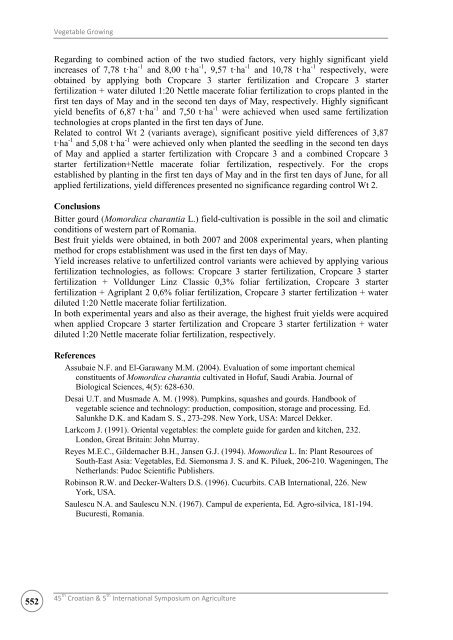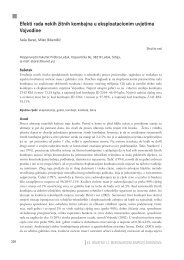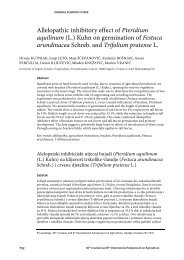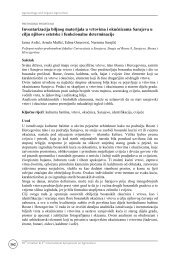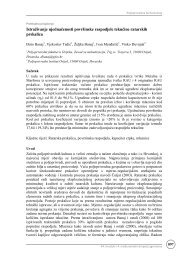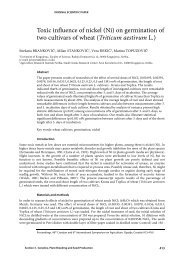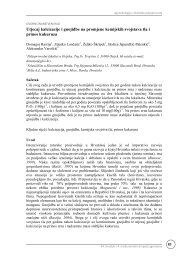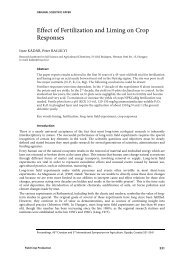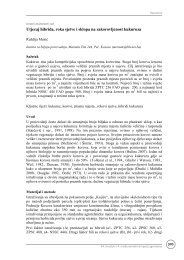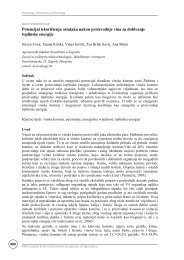SA2010 Paper Template - hr
SA2010 Paper Template - hr
SA2010 Paper Template - hr
You also want an ePaper? Increase the reach of your titles
YUMPU automatically turns print PDFs into web optimized ePapers that Google loves.
552<br />
Vegetable Growing<br />
Regarding to combined action of the two studied factors, very highly significant yield<br />
increases of 7,78 t·ha -1 and 8,00 t·ha -1 , 9,57 t·ha -1 and 10,78 t·ha -1 respectively, were<br />
obtained by applying both Cropcare 3 starter fertilization and Cropcare 3 starter<br />
fertilization + water diluted 1:20 Nettle macerate foliar fertilization to crops planted in the<br />
first ten days of May and in the second ten days of May, respectively. Highly significant<br />
yield benefits of 6,87 t·ha -1 and 7,50 t·ha -1 were achieved when used same fertilization<br />
technologies at crops planted in the first ten days of June.<br />
Related to control Wt 2 (variants average), significant positive yield differences of 3,87<br />
t·ha -1 and 5,08 t·ha -1 were achieved only when planted the seedling in the second ten days<br />
of May and applied a starter fertilization with Cropcare 3 and a combined Cropcare 3<br />
starter fertilization+Nettle macerate foliar fertilization, respectively. For the crops<br />
established by planting in the first ten days of May and in the first ten days of June, for all<br />
applied fertilizations, yield differences presented no significance regarding control Wt 2.<br />
Conclusions<br />
Bitter gourd (Momordica charantia L.) field-cultivation is possible in the soil and climatic<br />
conditions of western part of Romania.<br />
Best fruit yields were obtained, in both 2007 and 2008 experimental years, when planting<br />
method for crops establishment was used in the first ten days of May.<br />
Yield increases relative to unfertilized control variants were achieved by applying various<br />
fertilization technologies, as follows: Cropcare 3 starter fertilization, Cropcare 3 starter<br />
fertilization + Volldunger Linz Classic 0,3% foliar fertilization, Cropcare 3 starter<br />
fertilization + Agriplant 2 0,6% foliar fertilization, Cropcare 3 starter fertilization + water<br />
diluted 1:20 Nettle macerate foliar fertilization.<br />
In both experimental years and also as their average, the highest fruit yields were acquired<br />
when applied Cropcare 3 starter fertilization and Cropcare 3 starter fertilization + water<br />
diluted 1:20 Nettle macerate foliar fertilization, respectively.<br />
References<br />
Assubaie N.F. and El-Garawany M.M. (2004). Evaluation of some important chemical<br />
constituents of Momordica charantia cultivated in Hofuf, Saudi Arabia. Journal of<br />
Biological Sciences, 4(5): 628-630.<br />
Desai U.T. and Musmade A. M. (1998). Pumpkins, squashes and gourds. Handbook of<br />
vegetable science and technology: production, composition, storage and processing. Ed.<br />
Salunkhe D.K. and Kadam S. S., 273-298. New York, USA: Marcel Dekker.<br />
Larkcom J. (1991). Oriental vegetables: the complete guide for garden and kitchen, 232.<br />
London, Great Britain: John Murray.<br />
Reyes M.E.C., Gildemacher B.H., Jansen G.J. (1994). Momordica L. In: Plant Resources of<br />
South-East Asia: Vegetables, Ed. Siemonsma J. S. and K. Piluek, 206-210. Wageningen, The<br />
Netherlands: Pudoc Scientific Publishers.<br />
Robinson R.W. and Decker-Walters D.S. (1996). Cucurbits. CAB International, 226. New<br />
York, USA.<br />
Saulescu N.A. and Saulescu N.N. (1967). Campul de experienta, Ed. Agro-silvica, 181-194.<br />
Bucuresti, Romania.<br />
45 th Croatian & 5 th International Symposium on Agriculture


